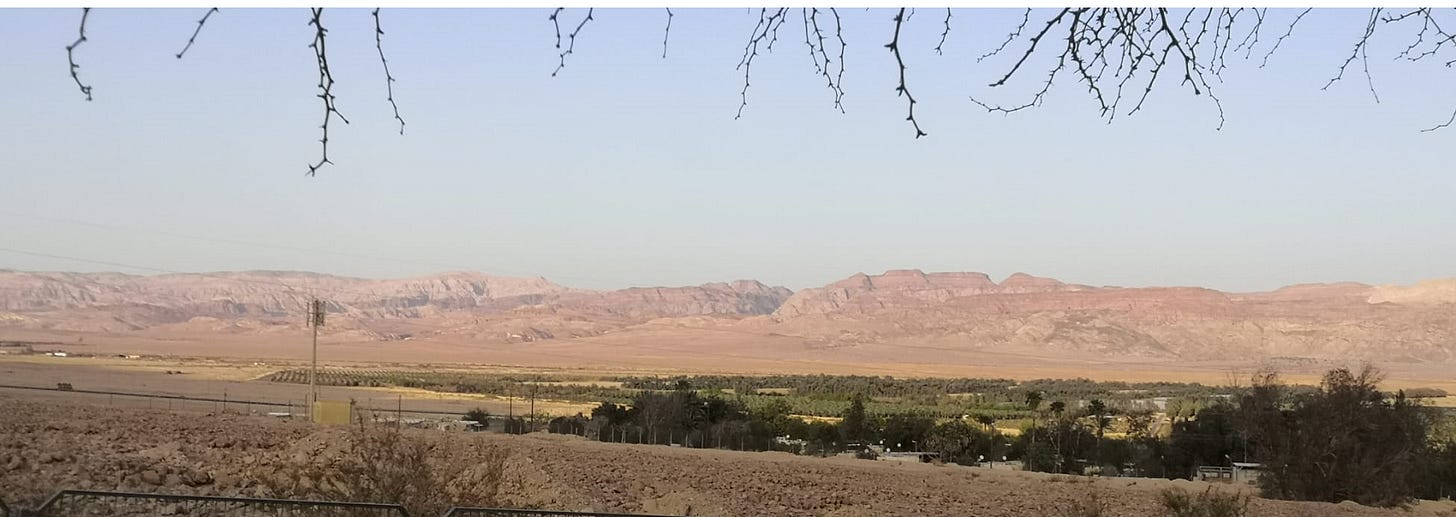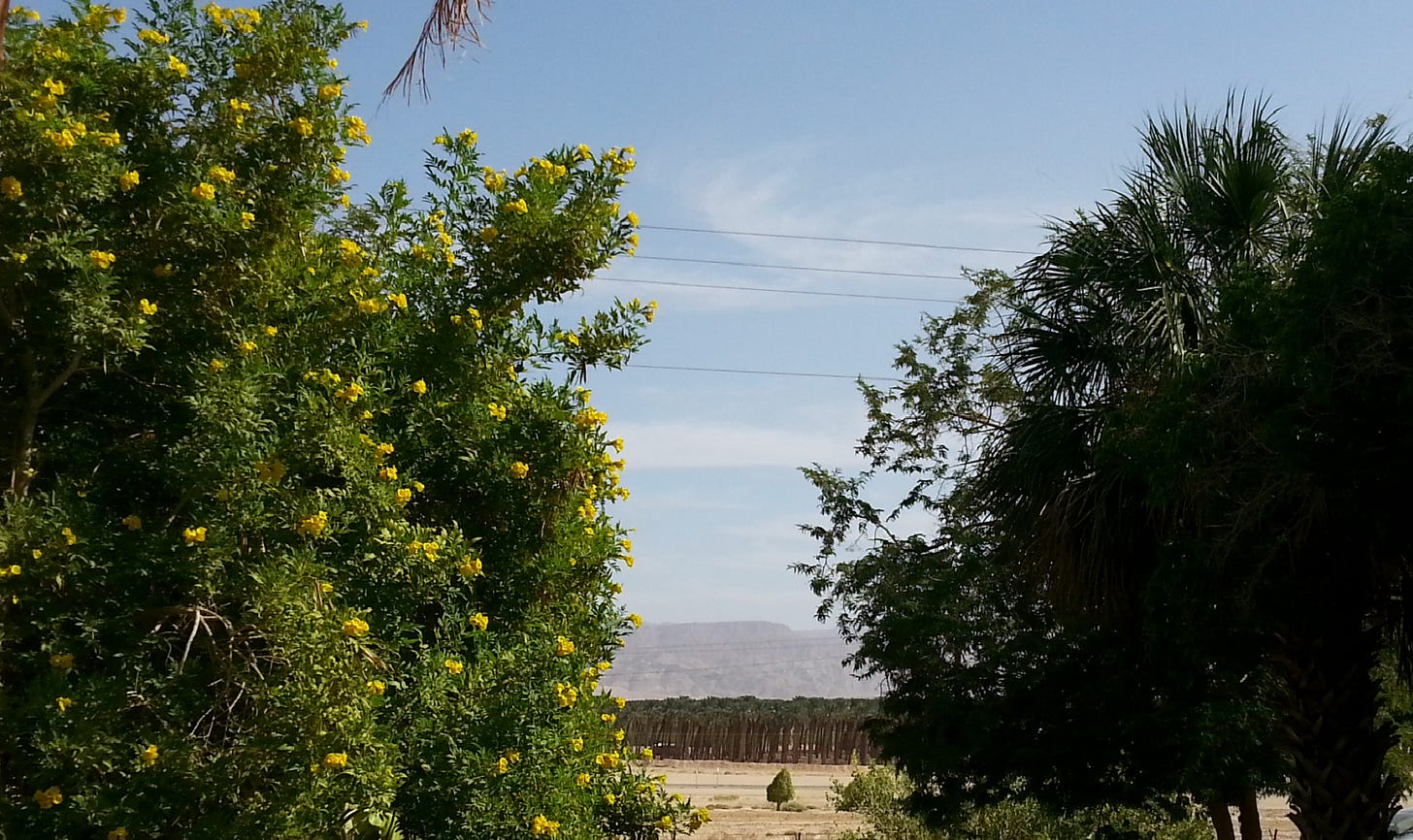One week, two kibbutzim
It was really by coincidence that I visited both Nir Oz, devastated almost beyond comprehension on October 7, and Ketura, in the same week. But together, they taught me about the meaning of community
Last week began for me with a visit to Kibbutz Nir Oz, and it ended at Kibbutz Ketura. The trips to the two communities – the first adjoining the Gaza border and empty of all its residents since the start of the Gaza war; the second seemingly isolated, deep in the Arava desert, 40 kms north of Eilat -- were unconnected. But they got me back to thinking about the meaning of this uniquely Israeli invention – the kibbutz – an institution written off long ago by so many.
Nir Oz was one of the communities hardest hit in the Hamas invasion on October 7, 2023. At the time of the attack, there 400 people were living on the kibbutz -- one quarter of whom were either killed or kidnapped that day. To date, more than 10 months after the attack, 33 remain in captivity (out of a total of 115), although it is not known how many of them are still alive. Nir Oz is also the lone kibbutz that was left to fend for itself on October 7: For reasons that remain unclear, it took the Israel Defense Forces more than seven hours to arrive at Nir Oz that day, by which time the marauders, perhaps 500 of whom had swarmed into the kibbutz a little after dawn, had gone back across the border, taking their captives with them.

From Mor Tzarfati, who led a small group of us around the kibbutz, I learned that only six of the 200 residences at Nir Oz were left undamaged by the onslaught, which was carried out with gunfire, hand grenades, arson, and more. The physical damage to the community will take some years to repair, but the psychological impact on those who survived that day now threatens to tear apart the collective, which is the most valuable component of a kibbutz.
After a brief period in an Eilat hotel, the survivors from Nir Oz were fortunate enough to be welcomed into apartments in a newly built neighborhood in Kiryat Gat, in the northern Negev. It was expected that they would remain there until their devastated kibbutz has been repaired. But now it turns out that a large percentage of the families, half or more, say they are unwilling to return to their old home. They say that they cannot imagine coming back to reside at the site where so many of their neighbors were killed, and they themselves experienced so many hours of terror.
Mor Tzarfati was lucky: She, her husband, Itai, and their three sons survived that day by locking themselves into their house’s safe room. When the terrorists arrived at their door, they tried every means they had to force the Tzarfatis out of the fortified room. Having failed after several hours, they set the apartment on fire, causing the safe room to fill with smoke. Which is when the Tzarfatis said their goodbyes to one another, and prepared to die from suffocation.
“I wasn’t willing to look the evil in the face with my own eyes,” Mor told us, with remarkable equanimity. “I knew that this was where I was going to end my life…. I was going to die. It had to be with my family.”

Mor said that by 1:30 P.M., seven hours after the assault on Nir Oz began, there was complete silence. “All we could hear was the sound of birds. I said that we must be dead. Itai said no, those are birds.” They had succeeded in cracking their safe room window and letting in enough oxygen to allow them to survive.
The army arrived at about 2 P.M, but it was about two more hours before a soldier arrived at the door of their safe room and told them it was safe to come out. When they emerged, they discovered that their house was still standing, but its interior had been largely destroyed by the fire. It remains today in the same burned-out state it was in that Saturday.
It occurred to me that, with the passage of time – wherever the people of Nir Oz end up, they will be living in Kiryat Gat for the next two years – maybe this recoil from the idea of returning to the old kibbutz could soften. But the group of those who want to leave don’t anticipate that happening. They want to remain together, but not at Nir Oz. In fact, they have already negotiated with another kibbutz, Beit Nir, about an hour to the northeast, to buy a plot of land there already zoned for new construction, and build their new homes there. To do that will cost what they estimate at $56 million, about half of which they say they will need to raise through philanthropic donations.
The decision to leave Nir Oz en masse almost inescapably puts them at odds with the other half of Nir Oz’s residents -- their neighbors who expect to return to a rehabilitated home. And for the potential funders, who include both the Israeli government and the Jewish Federations of North America, among others, it might not be possible to satisfy both camps, and some difficult decisions may lie ahead.
• • •
Not everyone would choose the month of August to drop in at the desert community of Ketura. This past Shabbat, the daytime temperature was 40 degrees Celsius (104 F). But our close friends on the kibbutz have a lot of commitments in their lives, so when they have a weekend free and extend an invitation for a visit, we generally grab it -- so long as the air conditioners are operating.
Emerging from the kibbutz dining hall following Shabbat dinner, our hosts suggested that my wife and I join them on the lawn outside for a special event, a “Hyde Park” evening. It had cooled off considerably, to a brisk 39 degrees (102 F), so we sat down to listen as a series of a half-dozen speakers stood on a platform of plastic crates to talk about how they imagined their home in another 25 years.
Ketura was founded in 1973, by olim (new immigrants) from the Young Judea Zionist youth movement in North America and the Israel Scouts. Sponsored as it was at the time by the Hadassah Women’s Organization, and lacking the kind of radical political ideology as the socialist-Zionist movement I belonged to as a teenager, I felt some condescension toward both Young Judea and its first and only attempt at setting up a kibbutz.

Suffice it to say that Ketura celebrated its 50th anniversary in 2023, that it has survived the heat, sun and barren landscape of the Arava desert, the financial near-collapse of Hadassah, which had entrusted many of its investments to Bernie Madoff) and that it is among a minority of the approximately 270 kibbutzim in Israel that has maintained the communal model, most having undergone privatization (“renewal,” in kibbutz euphemism) to some extent.
Ketura still maintains a dining hall (in fact, it was expanded last year), and on Friday evenings, the entire community convenes there for Shabbat dinner. This past Friday, the Kiddush over the wine was chanted by kibbutz member Yosef Kibita, who was born into the Abayudaya Jewish community in Uganda, and who, in his Sisyphean effort to be recognized as a Jew in Israel and gain citizenship, underwent conversion four times since 2002. Needless to say, Israel has not exactly opened its arms to this young African man who so wants to belong here, but Ketura did, and with the tireless efforts of the Masorti (Conservative) Movement (notably of the late Rabbi Andy Sacks), finally this week he was scheduled to be granted Israeli citizenship.
Most of Ketura’s members appear to be non-observant Jews, but the kibbutz has a functioning synagogue (egalitarian, of course), and a policy of Shabbat observance befarhesiya (in public), meaning, for one, that people refrain from using their phones in the dining hall on the Sabbath. It has the largest electricity-generating solar-collector field in Israel, and is the home of the Arava Institute for Environmental Studies, whose students include Israelis, Palestinians and Jordanians. One of Ketura’s cottage industries is Beertzinut, a producer of premium beers and ales. (“Beritzinut” means “seriously” in Hebrew).
Ketura is a success by many other measures too, having survived this long thanks to the stubborn idealism of its members, their openness to constant experimentation, and, most important, a sense of mutual responsibility shared by the 500 or so residents of the kibbutz. And then there is the natural beauty of its location, situated in the Jordan Rift valley, with the reddish mountains of Edom in Jordan to the east, and of the Eilat Mountains, just behind the kibbutz, to the west.
The ”Hyde Park” speakers that night radiated a confidence and optimism about the future that were out-of-place in the Israel of 2024. It seemed clear to me that they believe they have learned lessons over the past half-century that would serve the country well, but also that it’s not the Ketura way to preach to others – except, perhaps, for the speaker who prophesied that the entire kibbutz would be vegan by 2050 and the rest of the country would follow its example. But he also imagined that the kibbutz would have figured out how to move all its solar collectors to space and then to beam the energy generated back to earth where, among other things, it would be used to desalinate enough water to keep Israel and its neighbors wet.
One woman, who delivered her entire speech in rhyme, proposed fancifully that one way Ketura would contend with rising temperatures would be by starting the workday at dusk, with residents heading to bed as the sun was rising. Another painted a picture of a kibbutz where all the work was done by robots – benevolent ones, of course. And nearly all of the speakers talked about continuing to maintain the kibbutz’s openness to absorbing people, including refugees, from many different venues. They seemed to anticipate many “internal refugees” from Israel seeking shelter in their tolerant, pluralistic, compassionate community in the coming decades.
• • •
As we approached the end of our tour of Nir Oz with Mor Tzarfati, she said something surprising. For her, the most persistent trauma of October 7 comes from her memories of the scene at the Hamal, an acronym for “war room,” but in this case the logistics center where all of the survivors of the day’s atrocities, and the bodies of those who didn’t survive, were brought after the arrival of the army. She and her neighbors were dazed, injured and covered with ash, and they hadn’t had any water all day (and even now, had to restrict themselves to one cup each).
By 1:30 P.M., there was complete silence at Nir Oz. “All we could hear was the sound of birds,” recalls Mor today. “I said that we must be dead. Itai said no, those are birds.”
Mor was immediately recruited to take inventory of her neighbors, trying to determine who was alive, who had been killed, who was unaccounted for. She was seeing her neighbors, and they were seeing her, battered and at their most vulnerable, and she says that today that it was at “that same moment that I knew that, this is it, I will be here for my community forever.” Today, nearly a year later, she says that she is determined to work for her community, “in every way I am capable of, every possible way.”
That mutual commitment was the magic of the kibbutz as an institution, and it was delicate enough and subtle enough that it was perhaps inevitable that that magic would not be able to survive the winds of material wealth offered by an Israel that became increasingly prosperous starting in the 1980s. Today, one wonders if Israel is ready to listen and learn from the “ancient” wisdom that kibbutzim like Ketura and Nir Oz are still in possession of.




Beautiful. It feels like we are heading towards a moment of a revival of intentional communities, and I love the Hyde Park idea.